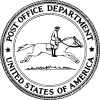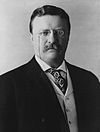Henry Clay Payne
Henry Payne | |
|---|---|
 | |
| Chair of the Republican National Committee Acting | |
| In office February 15, 1904 – June 23, 1904 | |
| Preceded by | Mark Hanna |
| Succeeded by | George B. Cortelyou |
| 40th United States Postmaster General | |
| In office January 9, 1902 – October 4, 1904 | |
| President | Theodore Roosevelt |
| Preceded by | Charles Smith |
| Succeeded by | Robert Wynne |
| Personal details | |
| Born | Henry Clay Payne November 23, 1843 Ashfield, Massachusetts, U.S. |
| Died | October 4, 1904 (aged 60) Washington, D.C., U.S. |
| Political party | Republican |
| Signature | |
Henry Clay Payne (November 23, 1843 – October 4, 1904) was U.S. Postmaster General from 1902 to 1904 under Pres. Theodore Roosevelt. He died in office and was buried at Forest Home Cemetery in Milwaukee, Wisconsin. He was also a chairman of the Republican National Committee.[1]
Biography
[edit]Payne was born in Ashfield, Franklin County, Massachusetts, on November 23, 1843, though his birth is sometimes listed incorrectly as September 23. He spent his youth in Massachusetts, and attempted to enlist for the Union Army, but he was rejected from service due to poor health. In 1859, he was graduated from the Academy of Shelburne Falls. In 1863, he moved to Milwaukee, Wisconsin, where he found work as a dry goods merchant.

In 1872 he began his political career with the Young Men's Republican Club of Milwaukee County. He worked his way up to become secretary and then chairman for the organization. In 1876, Payne was appointed Postmaster of Milwaukee, a position he held for the next ten years.[2] He transferred his organizational skills to his next position as president of Wisconsin Telephone Company in 1885, and served as director for the First National Bank of Milwaukee.
Railroads
[edit]Payne became a lobbyist for the railroad industry, described by long-time opponent Robert La Follette, Sr. as “the most effective railroad lobbyist I ever knew.” Starting in 1890 he helped Henry Villard acquire all the cars Milwaukee streetcar system for Villard's North American Company of New Jersey. Villard created a new system that combined several of the earlier horsecar, steam dummy, and streetcar lines into one electric streetcar system, The Milwaukee Electric Railway and Light Company. Payne was its vice-president as well as president of the Milwaukee and Northern Railroad and other enterprises controlled by Villard. In his duties as vice-president of the Milwaukee Electric Railway & Light Co., Payne instituted free park concerts at many of Milwaukee's parks, including Lake Park,[3] but fought Milwaukee's government in the courts and in the legislature.[4] In 1893 he was elected president of the American Street Railway Association; and later in August 1893, he was appointed receiver for the bankrupt Northern Pacific Railway.[5]
In 1896, Payne refused to provide a one-cent-an-hour pay raise which had allegedly been promised to unionized TMER&L workers. This set off a bitter strike and boycott; the company hired hundreds of scabs, and broke both the strike and the union, creating an adversarial relationship between TMER&L Co. and workers (including the city's powerful "sewer Socialists") for many years to come; the company would not be unionized again until after a 1934 strike. During this period, Payne continued to promulgate expanded streetcar and interurban services in the region, including a controversial 30-year extension of their franchise, a deal cut with Milwaukee Mayor David Rose and the Milwaukee Common Council under what some considered corrupt circumstances.[6][4]
He also engaged in real estate development, such as the 1897 "Payne's Park Addition" to North Milwaukee, fed by expanded streetcar lines running past what has been described as "two miles of vacant fields" and ending a few blocks past the street Payne had named after Villard in 1892.
Death
[edit]He died on October 4, 1904.[1]
References
[edit]- ^ a b "Henry C. Payne Dies In His Washington Home. Postmaster General Unconscious for Hours Before the End". New York Times. October 5, 1904. Retrieved 2015-01-25.
Henry C. Payne, Postmaster General of the United States, died at his apartments in the annex of the Arlington Hotel at 6:10 o'clock to-night. The cause of death was officially stated to be disease of the mitral valve and dilation of the heart. Mr. Payne had been in poor health for some years, but his last illness lasted only seven days. ...
- ^ Conard 1895, p. 297.
- ^ Conard 1895, p. 303.
- ^ a b Ranney, Joseph A. "Taming the jungle of public utilities". History of the courts How Wisconsin's judicial system was established. Wisconsin Court System. Retrieved 30 June 2021.
- ^ "Wisconsin Historical Society-Henry Clay Payne". Archived from the original on 2011-06-11. Retrieved 2008-08-16.
- ^ Moore, Karen W. "Mass Transit". Encyclopedia of Milwaukee. University of Wisconsin-Milwaukee. Retrieved 29 June 2021.
- Attributions
- Conard, Howard Louis (1895). History of Milwaukee from its first settlement to the year 1895, Vol. 1. Chicago and New York: American Biographical Publishing Co. Retrieved February 18, 2013.
Further reading
[edit]- Wight, William Ward (1907). Henry Clay Payne; a life. Milwaukee: Burdick and Allen. Retrieved February 5, 2022.
External links
[edit]- 1843 births
- 1904 deaths
- 19th-century American railroad executives
- 19th-century American merchants
- 20th-century American politicians
- Businesspeople from Wisconsin
- Northern Pacific Railway people
- People from Ashfield, Massachusetts
- Politicians from Milwaukee
- Republican National Committee chairs
- Theodore Roosevelt administration cabinet members
- United States postmasters general
- Wisconsin Republicans
- Burials at Forest Home Cemetery


